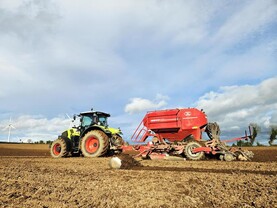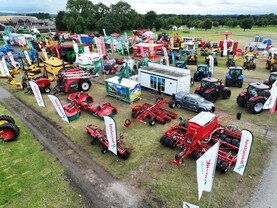Silage season is one of the busiest and most dangerous times on the farm. This week, we are taking a look at how to stay safe when you are making pit silage. When the grass is down and ready to be picked, things can get a little hectic. So it is always important to think safety first. This week we’re taking a look at some steps that can be taken to ensure safety during the silage season.
Tractor maintenance
Before the silage season gets into full swing, now would be a good time to service your machinery and carry out a proper check-up. Whether you are using your own machinery or you are hiring a contractor, all machinery should be in proper working order.
Along with all the major functioning parts of the tractor, the safety components of the vehicle should be checked. Mirrors, lights and beacons should all be working. Lights and beacons are particularly important for nighttime work so that oncoming traffic knows a big vehicle is approaching. Inspect the roll frame in the cab for rust or fracture. If any of the safety features are broken or damaged, replace them immediately and do not leave it to chance.
Around the pit
Around the slab can be especially dangerous with the high volume of traffic coming and going and the tractor/loader clamping the grass. Stay well back when the loader is coming towards you at the edge of the pit in case a bar from the fork or any other object comes loose from the machine.
Make sure the driver can see you and always maintain eye contact with the operator when approaching any vehicle.
Overhead lines
If you are working with any tall machinery, you must always keep overhead lines in mind. When driving on the road, know the height of the vehicle and remember that your trailer can be taller than the tractor. On smaller back roads, some power lines can be caused by damage from storms. Due to their remote location, they might not have been repaired.
In the field, hills and hollows in the ground can change the distance between the ground and the lines. So remain vigilant when driving under power lines. The obvious one to look out for is the arm and spout of a harvester as this is the tallest vehicle that will be in the field.
The other area where you could come into contact with power lines is on the pit. Even very high power lines pose a threat when the machine is elevated on top of the pit.
If you do come into contact with lines, remember to remain calm. If you are not in any immediate danger, do not leave the cab and call for help.
If you think you are in danger, do not step down from the cab. Jump as far as you can from the machine, making sure you do not make contact with the machine when you land.
Operating machines
When you are driving a tractor and trailer, ensure that the trailer is securely attached to the tractor and all lights are connected. Take extra caution when driving on smaller roads.
With heavy loads and big trailers, braking distance increases and the tractor can be harder to control. Try to park machinery on a level surface with the brakes on so it does not role when you exit.
Never turn on the tractor when you are not seated in the cab. In the field, take care over hilly terrain and steep slopes.
If the hill is exceptionally steep, drive up and down to prevent the trailer tipping over and only partially load the trailer for easier handling.
Children
During the summer months, children will be off school and could be out and about on farms. Young children can be very vulnerable as they aren’t aware of all of the dangers that exist around farms and machinery. Keep this in mind when driving on the roads and around yards.
Young children should not be around the farm when the pit is being made but if they are, always know where they are. With all of the reversing and blind spots that come with big machinery, it can be very easy for a driver to hit a child. Do not have children in the cab unless there is a designated seat and safety belt and they are seven years or older. Since 2007, 16 children have been killed by farm machinery.
Covering the pit
Never use the front loaders to lift people to or from the pit. When climbing the pit, use ladders and where possible climb the pit from the lowest point.
On top of the pit, stay as far away from the edge as possible so you do not fall or in case the side collapses away from the pit. Walled pits should have safety bars along the top to prevent people from falling over when they are working on top of the pit.






 This is a subscriber-only article
This is a subscriber-only article















SHARING OPTIONS: